INTRODUCTION
West Bengal has a repertoire of textiles in a variety of designs and manufactured by different techniques. The textile heritage of Bengal has many chapters… many tales… about singularity in diversity. Some of the most beautiful textiles of West Bengal have been chosen for this blog keeping in mind the uniqueness of the weaves, texture, and quality and I hope that Bengal’s fabrics, spun and woven by hand, would soon be on shop shelves nationwide!
ART AND CULTURE

One of the most culturally prosperous states of India, West Bengal is filled with surprises. Be it the different religions all assimilating into one of the lovely cultural events that seem to make up the glorious state that it is. There is much more to West Bengal than big red bindis and dhoti kurtas. There are a lot of elements about the culture of West Bengal, and now we are going to have a look at some of the interesting aspects of it.
Literature

West Bengal has a rich legacy of amazing literature with great authors like Sharat Chandra Chattopadhyay, Rabindranath Tagore, Kazi Nazrul Islam and Bankim Chandra Chattopadhyay contributing their fair share to the Bengali literature as well as to the world literature. The literature heritage extends well beyond that too. There has been a long tradition of folk tales like the Thakurmar Jhuli, stories of Gopal Bhar and much more which in their popularity bear a great resemblance to famous stories like Arabian nights and the Panchatantra. Bengalis have played a significant role in modernizing the course of Indian literature. Rabindranath Tagore even went on to win the Nobel Prize for Literature for his collection of poems – Gitanjali. There were several postmodernization movements in the latter part of the 20th century, some of them were known as the Kallol movement, Hungry movement, and Little magazines. These movements saw some emerging leaders who would go on to be prominent names in the Bengali literature circle like Sukumar Ray, Jibananda Das, Sunil Gangopadhyay, and Syed Mustafa Siraj being a few among them.
Theatre and Films
_20170828090849.jpg)
West Bengal has a long-standing tradition of folk drama known as Jatra. This form of theatre is a musical drama that depicts some stories in a melodious manner even while acting it out on stage. It used to be one of the ways to spread the story of Lord Krishna to people. The dialogues are all dramatic monologues, and nowadays the play is usually preceded by a musical concert to attract the audiences.
West Bengal has its own film industry known as ‘Tollywood’ as it is based in the Tollygunge region of West Bengal. It has a long list of acclaimed filmmakers both nationally and globally, including the Academy Award-winning film director Satyajit Ray. Other famous contemporary filmmakers include Rituparno Ghosh, Aparna Sen, Nandita Roy, etc.
Fine Arts
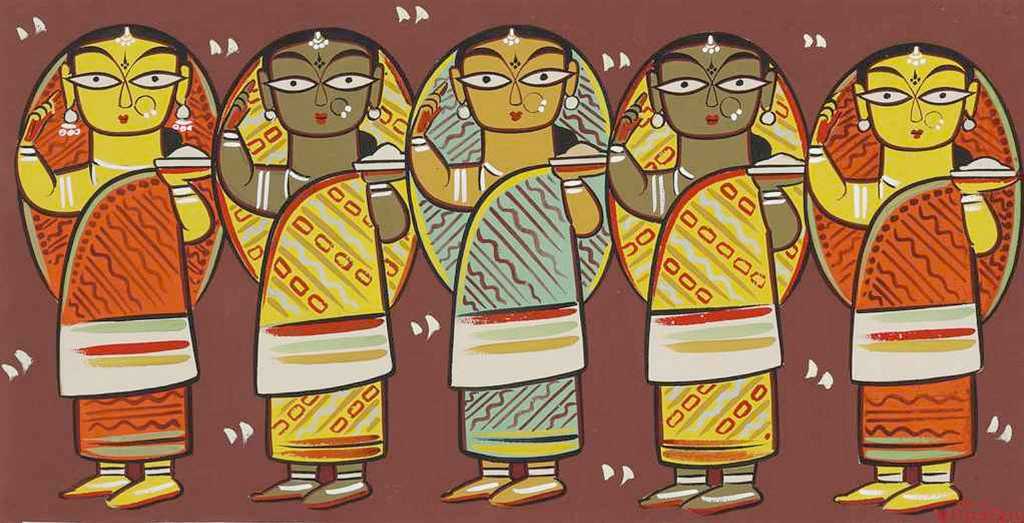
Bengal is credited to be the forerunner of modern contemporary art with famous artists like Abanindranath Tagore, Gaganendranath Tagore, Jamini Roy, Rabindranath Tagore being among the forefront to promote modernization of art in the country. Abanindranath Tagore is sometimes referred to as the ‘Father of Modern Indian Art’, and he went on to establish the Bengal School of Art to promote artistic styles out of the European influence. Even before the advent of modernization, there are numerous references to terracotta art and Kalighat paintings which show that art was loved for a long time in the region. After independence, a lot of graffiti with political propaganda went up on various walls of the state painting witty banters, limericks and of course party promotion. This continues to be popular even now. Due to a ban imposed on painting graffiti on private walls, the paintings are restricted to club walls.
Architecture
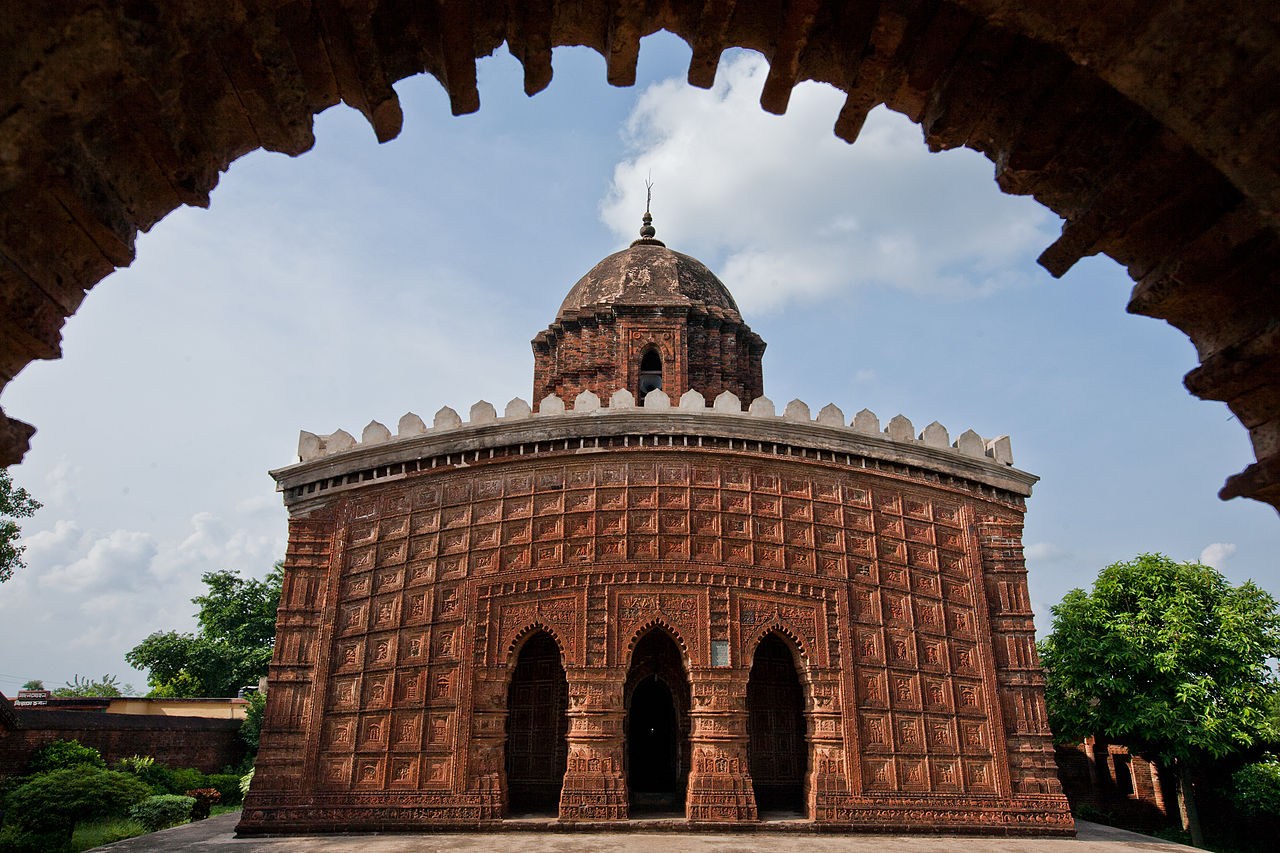
Architectural influences from different eras continue to be a part of the region. There are buildings of public and private use that show influences of Terracotta, Indo- Saracenic, Islam, and British. The city of Kolkatta used to be the Capital of India during the British reign and so it has a lot of buildings reflecting the British culture. There are various temples, mosques, churches, rajbaris (Home of the aristocratic people in the olden times). Kolkatta was once known as the ‘City of Palaces’. With the growing status as a cosmopolitan, Kolkata has flats coming up in its newer region.
Music and Dance
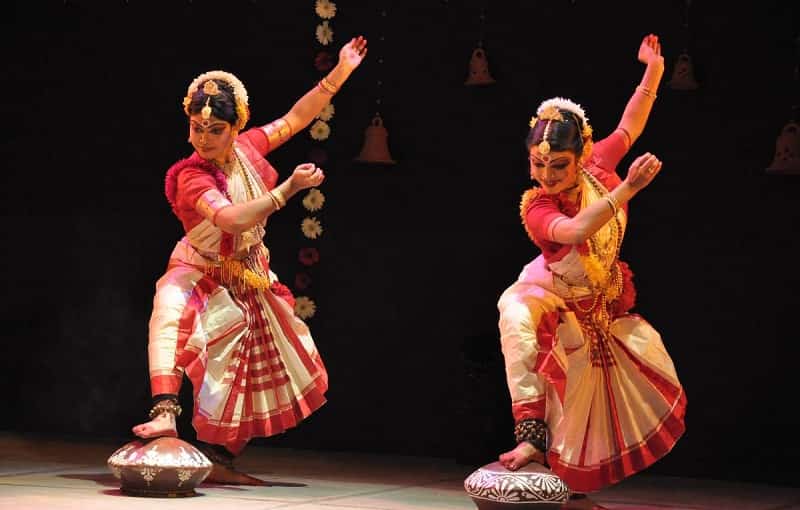
The amazing influence of regional music further increases the rich heritage of the region. Baul singing is perhaps the most famous of all the traditional singing of the yore. This involves singing a folk song about God, and one can see the powerful emotions that such type of singing evokes. The singer has his/ her eyes closed, completely lost in the moment- as if in a trance. There are other forms of folk singing too like Gombhira, Bhawaiya, and kirtans, etc. The region also has certain influences of the Indian Classical Music and Rabindrasangeet- made famous by the genius all-rounder, Rabindranath Tagore is considered to be a contemporary music option. In short, West Bengal has quite a rich variety of music.
Traditional dance forms like Chau originated in the state of West Bengal, where people wear huge colorful masks and dance.
Food Culture Of West Bengal

Food- something that we cannot live without, and Bengalis sure know how to enjoy theirs! Rice is a staple, owing to the enormous plantations of rice all across the state. Roti, Vegetables with thick curry, fish, egg and meat form staples of everyday life. Fish is found in many different varieties, and Bengalis have many unique dishes devoted to the same such as Malai curry of Prawn Fish, patori, ilish mach etc. The sweets of West Bengal are also very famous with majority of them are made of milk and its subsidiaries. The most famous are rasogolla, sandesh, rasamalai, homemade pitha, etc. which are loved throughout the country. The modern-day Bengali prefers to explore more, and so Anglo -Indian, Continental, Lebanese, Thai and Chinese are also preferred in addition to the traditional Bengali cuisines.
Festivals

West Bengal sees an array of festivals too, just like its other aspects. Durga Puja is the favorite festival of the region, witnessing a crowd from all over the world. It is the celebration of celebrating the victory of Goddess Durga over the demon Mahishasura. The roads are overcrowded till the nine days that the festivities are on. This festival is a lavish affair for the Bengalis with elaborate tents (known as pandals) going up in different parts of the state and people buying new clothes and accessories exclusively for this time of the year. Other festivals like Kali Puja (which is celebrated during Diwali), Lakshmi Puja (celebrating in honor of the Indian Goddess of Wealth), etc. are celebrated throughout the year.
SCHEDULED TRIBES IN WEST BENGAL
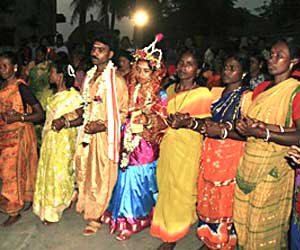
India is the home to a large number of tribal people, who are still untouched by the lifestyle of the modem world. Contrarily in the age of globalization, the extent and intensity of the deprivations of the tribals have intensified. India has the largest population of tribal people with more than 84.4 million constituting 8.20 percent of the population as per the 2001 Census. They are known as the Adivasis (indigenous peoples) and they belong to the section of the poorest of the poor in the country who are still dependent on nature for their survival through hunting, agriculture, and fishing, etc. 437 groups of tribals have been scheduled under the Constitution of India. The major tribal groups who have been scheduled in India include Gonds, Santals, Khasis, Nagas, Garos, Mundas, Oraons, Kharias, Hos, Angamis, Bhils, Kols, Chenchu, Kondadoras, Kondakapus, Totos, Paharis, Bhutias, etc. Each and every tribal people have their own distinct social system, culture, tradition, customs, values, language, and lifestyle, etc. So far as the state of West Bengal there are forty-one ( 41) schedule tribes and their concentrations are more in southern, western and northern parts of the state. As per the 2001 census, the scheduled tribe population of the state was 44, 06,794 of which 22, 23,924 males and 21, 82,870 were females. On the whole, they constitute 5.5 percent of the total population of the state in 2001 and most of them (93.9 percent) reside in rural areas. Among the tribes, the Santals constitute more than half (51.8 percent) of the population. The Oraons, Mundas, Bhumijes, and Koras constitute are 14 percent, 7.8 percent, 7.6 percent, and 3.2 percent respectively. Besides, Lodha’s, Mahalis, Bhutias, Bedias, etc. exist in small numbers. Even though Santals constitute the majority, they are concentrated in the districts of Purulia, Bankura, West Medinipur, Bardhaman and Hooghly districts of West Bengal. The decadal growth rate of 1991to 2001 of ST was 15.70 percent whereas India was 22.66 percent and West Bengal was only 17.77 percent respectively.
THE FOCUSED TRIBE: THE SANTALS
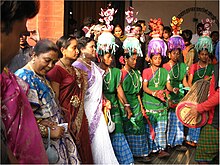
The Santals are one of the largest groups among the schedule tribe, next to the Gond tribe. They are residing in the states of West Bengal, Jharkhand, Orissa, Bihar, and Assam; in the present-day context, they have migrated to all the major cities of India. Besides, they are also residing in neighboring countries like Bangladesh and Nepal. The Santals call themselves Horhopon meaning child or children of human beings. They are known regionally as Santal, Santhal, Santa, and Sotar but as the Government records, they are mostly called either as Santal or Santhal. The researcher prefers for phonetic elegance the name spelled as Santal who considers themselves Hor or Hor Hopon. The Santals are considered one of the largest homogenous Scheduled Tribe (ST) in India. They are in India since time immemorial. It has been argued that the Santals are the only cultured people on the empress of the underlying philosophic speculation and order of the thought that was widespread in India prior to the rise and social order of pre-Dravidian (Mohapatra, 1986). Ethnically the Santal, Ho, Munda, and Kharia belong to the same family of Kolarian race and linguistically the Santals are grouped with the Munda family of languages. Their past history is very vague as they had only oral traditions. During the first half of the 20th century, documentations have been started by anthropologists, sociologists and interested Christians missionary.
Textiles
Cotton Textiles of Bengal:
Jamdani is a part of Bengal textile heritage. Interesting point: ‘Jam’ means flower and ‘Dani’ means vase so you can expect floral motifs. Basically, Jamdani is a dress material though these days we come across it in the form of a sari… whether it is created in a simple frame or pit looms. For traditional Jamdani weaving, an elementary pit loom is used and the work is carried out by a weaver and his apprentice who use fine needle-like spindles to conjure magic with weft work that can rival the most intricate embroidery. During the process of weaving a paper pattern is kept beneath to act as a trace to transfer the design. There is a key difference in the weaving technique between Jamdani and Tangail: the embroidery thread in Jamdani is inserted after every ground pick whereas in Tangail the embroidery thread is inserted after two ground picks. The main characteristic of Tangail is the butis i.e. tiny motifs all over. Traditionally Jamdani is woven in white with bleached white geometrical designs. Sadly, as an industry Jamdani production is on the decline and highly skilled weavers are finding it difficult to keep the tradition of their forefathers alive. While the quality of the sari has to be maintained to ensure appreciation… there must be an effort to promote the beautiful traditional Jamdani saris.

Nilambari: (literally meaning ‘blue as the sky’) is a legendary indigo-dyed cotton handloom sari. Like a midnight blue sky is offset by the moon similarly a Nilmbari sari is offset with a silver zari border. The ‘pallu’ is adorned with stripes of different thicknesses called ‘Sajonshoi’ and complements the border. Very fine hand-spun yarn of 250-300 count is used for weaving and results in a fine texture.

Shantipuri: Shantipur specializes in weaving fine-textured saris and dhotis while coarser ones are meant for everyday wear. It is still being produced in the traditional method today and one can see patterns and colors found in ancient times reflected in the garments produced in the vast textile belt of Shantipur which is the hub where fine-textured saris with a uniform weave of 100-112 counts in the warp and the weft are produced. When the decoration is the same on both sides of the cloth it is called Do-Rookha or double-sided designs. The borders could be either dyed cotton-silk or art-silk or viscose yarns or zari work. The background has fine delicate checks, stripes or a texture created by colored threads or a combination of fine and thicker yarn. The pallu of the sari has butis or Jamdani designs beautifully arranged with stripes of different widths. Some tie-and-dye designs are also being used for the anchalas of Shantipur saris.

Dhaniakhali: The Dhaniakhali district of Hooghly specializes in making saris in pastel shades (Begumpur have deeper and brighter hues). Earlier it was famous for dhotis but as demand lessened, the weavers switched over to saris. The material is a bit coarse and heavier than other textiles from Bengal but suits all budgets and is popular.

Silk Textiles of Bengal:
The cultivation of mulberry silk and its weaving is carried out in the plains of West Bengal. The other districts where silk yarn is made are Murshidabad, Birbhum, Bankura, Maldha and Purulia districts. The district of Maldah on the north bank of the Ganga is one of the most important centers for silk rearing in West Bengal.
Baluchari is an elaborately woven brocade known to have been made during 1850-1900 in the village surrounding Baluchar (Murshidabad Distt.) it is popular because of its artistic and unique design. Tapestry material is made from Baluchar silks which were originally used by nawabs and Muslim aristocrats of the Murshidabad district while Hindu noblemen used raw silk. Baluchari saris have a wide pallu with a panel of mango or paisley motifs at the center surrounded by small rectangles depicting different scenes. The borders were narrow with floral and foliage motifs and the fall was covered with small floral designs in bright colors. Another familiar motif was diagonal butis. The unique feature is the combination of animal and bird motifs with floral and paisley motifs and motifs depicting hunters on horses and elephants and scenes from the nawab’s court. The silk yarn used for Baluchar saris was not twisted and had a soft heavy texture. Limited ground colors were used which were permanent in nature and retain their freshness even after years.

Cowdial: Murshidabad is famous for its cowdial saris made of fine mulberry silk with flat deep-red or maroon borders made with three shuttles and laced with fine serrated design in gold zari. The fine gold lines are supposed to represent the fine trail left on its path by a live cowrie mollusk, thus giving the name: cowdial. Murshidabad silks are also popular for hand-printed designs. Calcutta and Srirampur in the Hooghly district are the main textile hand-printing centers in West Bengal.

Vishnupuri: Traditional silk sari weaving is also done at Vishnupur in the Bankura district which bears similarity with the kataki designs of Orissa. In the districts of Bankura, Birbhum, Purulia, Murshidabad, and Maldah the weavers make plain silk fabrics in rich and varied textures using Tussar and mulberry silk.

JUTE:

For centuries jute has been an integral part of the culture of southwest Bangladesh and portions of West Bengal. During the British Raj, much of the raw jute fiber of Bengal was carried off to the United Kingdom where it was processed in mills concentrated in Dundee. Initially, due to its texture, it could only be processed by hand until it was discovered there that by treating it with whale it could be treated by machines. The industry boomed (“jute weaver” was a recognized trade occupation in the 1901 UK census) but this trade had largely ceased by about 1970 due to the appearance of synthetic fibers. The Tossa Jute in West Bengal is silky, shiny and strong. This jute mixed with raw silk is popular among Indian women.
West Bengal happens to be a major jute growing state and nearly 9 0% of the Indian jute mills are located in the eastern region.’ The state produces over 70% of the country’s total jute crop and South Bengal contributes a major portion of it.^ Bengal and the jute industry are inseparable. Jute is mainly grown in West Bengal, Meghalaya, Assam, Bihar, Orissa, Andhra Pradesh, and Tripura. There are adequate reasons for the concentration of jute mills in this area. These are the monopoly of Bengal in jute production, at least before partition, cheap transportation of raw jute from interior areas particularly in what is now East Pakistan, by waterways to Calcutta, advantages that Calcutta as a port enjoys for exports as also for the importation of various mill stores and the importance of this city as the seat of a large and influential group of managing agents.^ The Jute Mill Industry is one of the oldest and the most well organized of India’s manufacturing industries. The industry owes its origin and development to British enterprise and capital. It is a precious asset of the nation. Hessian and sacking are the bread and butter of the industry and will remain so for many years to come. Jute is the principal foreign exchange earner for the nation and it plays the most vital part in our national economy. Next to cotton, the jute mills in India represent the second-largest industrial investment of the country. Even as a means of providing employment, the jute industry ranks as a good second after cotton. The industry is one of the major employers of industrial labor. So it is the most employment-intensive organized industry. Jute agriculture is also highly labor-intensive. Jute, the golden fiber, has gained immense popularity around the globe. The jute industry has been developed principally as an export industry with almost a monopoly position in the past. Jute is very much part of national wealth. As an industry, it spans two vital sectors in the country’s economy namely, agriculture and industry. On the agricultural side, it provides the means of livelihood to nearly 2 million agriculturist families, and on the industrial, to about 3,00,000 workers. It is said that almost every 4’“^ man in West Bengal malces a living directly from jute and jute products.’ The jute industry occupies an important place in India’s economy, contributing over Rs2000 million in foreign exchange every year on an average. In the economy of the State of West Bengal particularly the industry has a unique position. 2 persons in that state out of every 5 owe their living to jute. The jute mills employ roughly a sixth of West Bengal’s organized industrial labor. The industry employs more than 2,07, 000 persons and the investment in the productive capital is more than Rs870 million. The present production capacity of the industry is estimated at about 1.25 to 1.3 million tonnes per annum.

The history of the modem jute industry is most interesting. The early history of the jute industry is replete with periodic booms followed by periods of crisis. The last few years, however, have witnessed the onset of an acute crisis, which threatens to become cronic. Most of the people are of the opinion that the jute industry has become a sunset, moribund and dying industry. It is an ailing industry and has no future. But the picture is different. Jute products range from traditional packaging materials to newer products. Traditional packaging materials include hessian, sacking and carpet backing cloths and yarn. Newer products include vegetable oil treated food grade bags, home textiles, floor coverings, hand and carry bags for consumer use, travel bags, handicrafts. That is to say that the jute industry has also made a dent into areas of aesthetic lifestyle products, which are also eco-friendly and durable. Jute geotextiles have tremendous application in solving different problems in areas like riverbank protection, soil conservation, strengthening of road sub-grades, management of hill slopes, overburdening dumps in mines and stabilization of earthen embankments. The government has come forward for the revival of the so-called ‘Sunset’ industry and allowed some sops for setting up the jute industry.
The GROWTH OF LEATHER INDUSTRY IN CALCUTTA:

West Bengal has had a long history of leather production. Its leather products made in thousands of big and small-scale units have occupied a position of prestige for many years. The state is a pioneer in the manufacture and export of artistic leather goods, shoes, and sports goods. Kolkatta has been the premier chrome tanning center in the country for several decades.
Though the tanning industry in Kolkatta made its beginning in the present century, Kolkatta had become an important port for leather export long ago. Leather trade with Europe and America had been definitely established in Kolkatta by the 1820s.
The leather industry in Kolkatta took roots in the eastern part of Kolkatta viz., Dhapa, Tangra, Tapsia and Tiljala. These are marshy areas in which are found a good number of big tanneries as well as small ones with thatched roofs. Besides the Indian nationalists and Europeans, people of Chinese origin residing in Kolkatta also became active in this business. These Chinese were originally from the Kwangtung province of South-east China who had specialized in this business. The language spoken by them is known as Hakka. At the close of the nineteenth century, they established themselves in Tangra and Dhapa areas of Kolkatta and gradually opened small tanneries using vegetable and alum tanning processes. Their shoe-shops in Dharmatala also became famous all over Kolkatta. The first Chinese tannery known as Fe Shien Tannery came up in 1902 producing vegetable tanned leather for shoe-uppers. This Chinese tannery was soon followed by others and by 1918 there were nine Chinese tanneries in Kolkatta. These tanneries gradually changed over from the vegetable tanning process to the chrome tanning process. 8 9 Besides the Chinese, a group of Chamars from Punjab began producing bag tanning sole leather 10 from buffalo hides in the Tiljala area around this time.

The Second World war proved to be a big stimulant to the leather industry in Calcutta. All the big tanneries were put under the control of the Government. The entire capacity of the controlled tanneries was reserved for defense production. These tanneries were allowed to sell only their rejects in the open market. This gave the small tanneries an opportunity to capture the home market. This advantage WaS fully utilized by the Chinese tanners in Kolkatta and their number increased to 70 during 1940-45. To meet the market demand for leather during the war period, the Chinese tanners expanded their production using advanced processes.
With the dawn of Independence, vigorous programs of industrialization were launched to accelerate the pace of economic development in the country. It was hoped that the leather industry in Bengal would take advantage of the new political environment and increase productivity! ve capacity and output. Unfortunately, however, tanneries in West Bengal faced a crisis in the form of a serious shortage of raw hides. This was due to the following reasons: First World war II encouraged the growth of the leather industry no doubt, but it brought down the cattle population. To meet the requirements of meat for the army, India supplied her healthy and best qual! ty of buffaloes and goats. Second, was the partition of India in 1947 which cut off the West Bengal tannerie·s of their sources of raw hides. Earlier tanneries in Kolkatta used to receive large amounts of raw hides from Dhaka and its adjoining areas. With the partition and creation of •East Pakistan’ consisting of Muslim dominated areas of Bengal the supply of raw hides dried up. 15 Prices of raw buffalo calf-skins, cattle-hides increased tremendously in this period.
The leather footwear industry in Kolkatta comprises mainly of small and cottage units scattered all over the city. The small scale units in Kolkatta produce western and Indian types of shoes. There are over a hundred shoe units owned by the Chinese in central Kolkatta. They produce ladies and gents shoes of the latest design by employing Bihar! Mochis. The Chinese sell their shoes through their shops in New Market and Bentick Streets which are very busy business centers in central Kolkatta.
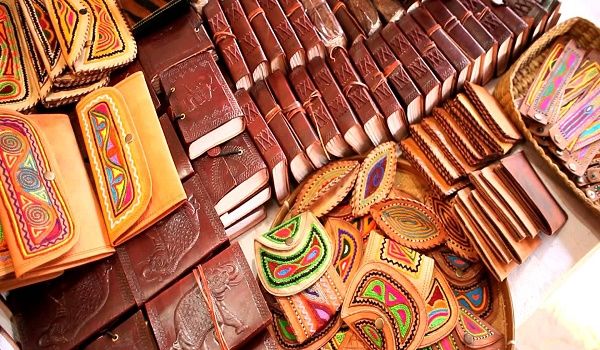
Embroidery
Kantha
From rags to beautiful embroidered riches
The Sanskrit word kontha means ‘rags’. One legend links their origins to Lord Buddha and his disciples, who used to cover themselves with garments made from discarded rags that were patched and sewn together. Rags displayed at Indian shrines or tied to tree limbs symbolize prayers and wards off the evil eye. The oldest existing examples of kantha, date from the early 1800s. They are embroidered with blue, black and red threads that were unraveled from sari borders. Because they were salvaged from used garments that had been frequently laundered, the colors tend to be muted.

There are seven different types of kantha:
1. Lep kantha are rectangular wraps heavily padded to make warm coverlets. The entire piece would be stitched in wavy, rippled designs over which simple embroidery was executed.
2. Sujani kantha are rectangular pieces of cloth used as blankets or spreads on ceremonial occasions.
3. Baiton kantha are square wraps used for covering books and other valuables. They are elaborately patterned with borders of several rows of colorful designs.
4. Oaar kantha are rectangular pillow covers in simple designs with a decorative border sewn around the edges.
5. Archilata kantha are small, rectangular covers for mirrors or toilet accessories with wide, colorful borders in assorted motifs.
6. Durjani/thalia kantha are small rectangles with a central lotus design and embroidered borders. Three corners of the rectangle are folded inward to form a wallet.
7. Rumal kantha are used as absorbent wipes or plate coverings. They also feature a central lotus with ornamented borders.
Dorokha or the double-sided kantha that has either an identical pattern or sometimes a different pattern at the back of the embroidery. So it is true reverse embroidery.
Costumes of Bengal for Men and Women
Whether you talk about West Bengal or Bangladesh, the traditional culture of both places is the same. They were one before the partition of East Pakistan in 1947, presently known as Bangladesh. So, people of these places almost follow the same culture and like to wear similar types of dresses. Men and women in Bengal are very religious and wear clothes according to the festivals as well. Bengal Traditional costumes are very simple and seem calm. They represent the rich tradition and culture of the region. Men like to wear Dhoti and women love to wear saris. There are many varieties of designs and colors studded on the saris in Bengal.
Whether you talk about West Bengal or Bangladesh, the traditional culture of both the places is the same. They were one before the partition of East Pakistan in 1947, presently known as Bangladesh. So, people of these places almost follow the same culture and like to wear similar types of dresses. Men and women in Bengal are very religious and wear clothes according to the festivals as well.
Costumes of Bengal represent the rich traditional culture of the region. While Punjabi form and Dhoti are common dresses among men, women love to wear saree. Colorful dresses can be found in different cities, towns, and villages throughout Bengal. Exciting dresses make the place really astonishing. These traditional and cultural dresses are exported throughout India and other parts of the world. There are many importers who are interested in buying Bengali dresses.
Such outfits can be easily bough simply by contacting any online retail shop. Even you can pay the price via the internet and the dress will be delivered to your shipping address within a few hours/days depending upon the set delivery deadline of the vendor. The designs and styles of dresses are the personification of fabulous craftsmanship of wearers. Such outfits have national and international demand attracting people from their elegance.
In today’s time, mostly youngsters attract and adorn western clothing like skirt, shirt, trouser, jeans, tops, t-shirt etc. This commonly happens in cities like Kolkata and Dhaka. However, during festive seasons like Durga Puja you can find devotees wearing traditional clothing.
Costumes for Men in Bengal
Dhotis are commonly worn by Hindus. The dress is a long loincloth made of silk or cotton. Dhoti forms a traditional dress for men in West Bengal. Previously, Dhotis are prevalent only in white color but nowadays different colors of Dhotis available in the market. You can pick any one of them as per your favorite color choice and other matching stuff.
Lungi is also like dhoti which is widely known for a traditional dress for men. It is worn around the waist just like dhoti. Men living in villages usually wear it on a regular basis. So, it can be called as their main outfit.
Punjabis are loosely fitted clothing that reaches close to the knees. There are available in wide verities and can be found in various colors. These are like Kurtas worn by men in North India. Punjabis are normally made of cotton or silk.

Costumes for Women in Bengal
The typical Bengali fashion for women can be seen in Saree (Sari). This is one of the topmost traditional and widespread dresses for ladies. Generally, the West Bengal sarees are designed by silk or cotton. Salwar Kameez has also become a common dress among girls. These are available in various designs and colors in the stress markets or shopping centers.

Bengali festival dresses
On the festive and religious ceremonies, Bengalis are clad in their traditional costumes. During the celebration, Bengali men wear traditional cotton or silk “dhoti” and North Indian style kurta.
Bengali women wear fine silk or cotton sari designed according to the importance of the occasion. The fabric of the Bengali cotton sari is unique with the premium quality produced by local weavers known as “tantis”. They are expert weaving fine quality fabric with refined thread work. Bengali silk sari is famous for its rich, sophisticated and elegant quality and texture. Cotton saris as Jamdani and Baluchari and silk saris are most preferred wearing on festive and religious occasions.
The typical Bengali style of draping a sari is altogether different where the sari is not pleated but the “Pallu” is kept loose over the left shoulder with a bunch of keys tied with the knot.
Bengali Wedding Dresses
A wedding is the most important occasion of life, which involves a lot of joy and sentiments when the bride leaves back a lot of memories of her maternal house and step into a new family to begin the second phase of her life with her life partner. It is the reason for both the families to celebrate the union of the couple with great pomp and show.
Bengali groom is neatly dressed in crème colored silk dhoti and Kurta with a gorgeous turban that covers his head gives him a royal look.
The Bengali Hindu bride is very specially treated on the D-day with care, affection and lots of love. The true essence of the Bengali wedding is found in the bride who looks extremely awesome in a traditional silk sari. The Bengali bride is dressed in red or crimson-colored rich golden embroidered Banarasi silk saree complemented with traditional Bengali jewelry. The head is covered with a red-colored beautiful veil or “mukut”, forehead adorned with attractive patterned red Bindis increasing the beauty and charm of the girl. The red color is considered auspicious. However, today’s modern bride prefers to wear a pink or maroon color sari. Modern fashion designers play an important role in coming up with new variations in a red color sari to give a more traditional and contemporary look.
Both Hindu Bengali bride and groom wear white floral garlands, which were exchanged at the time of “Mala Badal”ritual that accompany a whole recital of Vedic mantras. It is difficult to say whether the Bengali wedding couple or the ceremony which one is more gorgeous and elegant.

Headgear :- Topor

Historical Significance Of ‘Topor’
According to a legend, the Topor was created because lord Shiva wanted a special crown for his wedding ceremony. He commissioned his artist Vishvakarma to create a headgear especially for him. Visvakarma was used to handling only hard materials so he was unable to complete the job. The Lord summoned a young handsome man named Malakar to made the gear using shola ( Thermocol). Since then, the Topor is used extensively in Hindu weddings.
Importance Of The ‘Topor’
Topors made of Shola have significant importance in Bengali matrimonials as they are known to bring good luck. As per tradition, the groom must receive the topor from the bride’s side, usually from the father-in-law and it is worn before the wedding takes place.
Conventionally, it is said that if the topor of any other accessory made of Shola breaks, it must be cast in water. According to tradition, the topor and accessories emerge in a pond so that no one can destroy them. If a topor accidentally catches fire, it is considered bad luck for the couple.
This beautiful and symbolic topor is a must for every Bengali groom and it enhances the look and the attire of the groom.
Special Accessories & Jewelry
Ivory jewelry and accessories are gifted to Bengali bride at the time of the wedding. Traditionally, ivory is referred to as hard, cream or white colored tusks of animals like elephant, whale, hippopotamus, boar, etc. It is very soft material required expert artisans and craftsmen to design and carve ivory jewelry. The softness and skills required to carve designs into ivory results in very costly jewelry. Bangles and pendant are the most famous ivory jewelry worn by traditional married Bengali women.

The rose water sprinkled brooches, pendants, hairpins, hair clasps, nose ring, armlets, and necklace forms the traditional Bengali jewelry. These ornaments are lighter in weight, which requires a lot of intricate work to design by the skillful artisans.
“Tikli”, “Kaan”, “Chik/Choker “, “Chooris/bangals/Chur”, “Ratanchur”, “Mantasha” are the traditional ornaments that are worn by the Bengali Hindu bride and married women on special occasions. “Hansuli”, “Baju”, “Taabiz” and “Taaga” are traditional ornament, which is worn especially by Muslim Bengali women.

“Tikli” is forehead ornament worn in the center part of the hair. It is laced with a string of pearls and studded with precious stone, gold or silver design. “Kaan” is ear shaped earring made from thin gold or silver sheets embedded with precious stones. “Chik/Choker” is an inch wide necklace studded with diamonds and stones. The necklace with five or seven strands of studded stones is known as “Sapta Lahiri” or “Pancha”. “Chooris” or bangles are typically crafted in gold and silver. Bengali married women wear a pair of 3 bangles, one made from conch shells, the second made from iron and the third made from thick gold or silver known as “kankan”. Kankan is considered auspicious as it forms makara pair or mythical crocodile heads at the end point. “Chur” is a gold bracelet traced with older paintings and sculpture. “Mantasha” is an elegant bangle studded with stones and pure pearls. “Ratanchur” is gold and silver ornament with its origin from Mughal Empire. It is five rings ornaments worn each ring in each finger and one on the thumb connected with five chains attached with ring and an armlet. The point where armlet is connected with five chains is decorated with designs like moon, sun, lotus etc. Bengali wear special designed “payal” with toe rings connected with plain or designed chains on their anklets with small hanging bells.
Tourism guide:- https://www.wbtourismgov.in/
The article was written by – Ms. Ayman Satopay. B.Sc in Textile and Apparel Design from Sir Vithaldas Thackersey College Of Home Science. Textile Value Chain intern. Email: [email protected]
